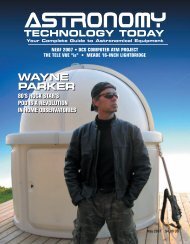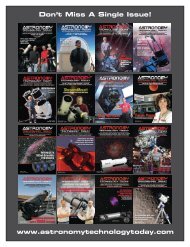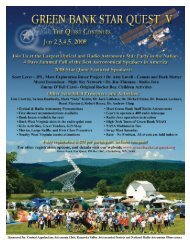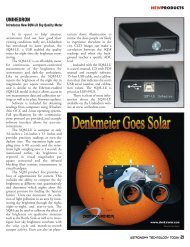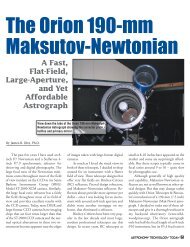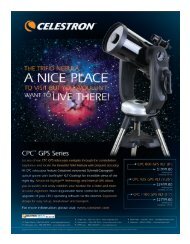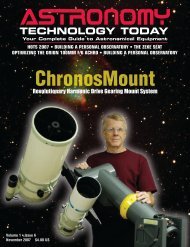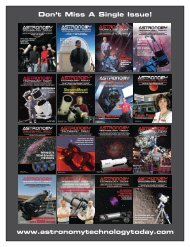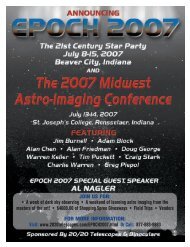magnilux - Astronomy Technology Today
magnilux - Astronomy Technology Today
magnilux - Astronomy Technology Today
You also want an ePaper? Increase the reach of your titles
YUMPU automatically turns print PDFs into web optimized ePapers that Google loves.
ASTRO-TECH 8-INCH IMAGING NEWTONIAN<br />
play to allow something to be inserted<br />
into it, but I think I was close enough. I<br />
know now why laser collimators are so<br />
popular. Using the Cheshire is a bit of a<br />
pain in the dark, but it is quite accurate.<br />
I finally succumbed and bought a laser<br />
which I use with my Celestron Ultima<br />
Barlow. It works beautifully day or night.<br />
Image 3 shows stars in all four corners<br />
of a Canon DSLR frame along with<br />
one from the center. The top-right image<br />
seems to show some elongation while the<br />
others are fairly free of this. Was the<br />
camera slightly cocked in the focuser<br />
Who knows<br />
My targets for the night were the<br />
ever-elusive Crescent Nebula<br />
(NGC6888) and the PacMan Nebula<br />
(NGC281). The Crescent continued to<br />
be elusive and, until I decide that narrow-band<br />
imaging is in the cards, it will<br />
remain so. PacMan on the other hand<br />
gave up its photons nicely as demonstrated<br />
in Image 4. For anyone interested,<br />
that is ten 5-minute subs<br />
processed with darks and flats. None<br />
were discarded.<br />
The AT8IN/MPCC duo gave me an<br />
image with very nice stars (not perfect)<br />
to the corners. Any remaining bits of<br />
coma I saw in the corners were most<br />
likely due to imperfect collimation. Star<br />
colors were faithfully rendered in my<br />
Canon/Hutech 500D and there was<br />
ample contrast. I’ll bow to the marketers<br />
and attribute this to the long snout and<br />
baffles.<br />
Visual Function<br />
I wanted to test the AT8IN visually<br />
so, one night when the local club was<br />
gathering at our dark-site, I loaded up<br />
the scope and my modified Sky Watcher<br />
HEQ5 and voyaged off into the gathering<br />
dusk. (Note: The coma corrector was<br />
not in the optical path as I don't have<br />
the correct accessories to use it visually;<br />
all of the reports are with a “naked,” uncorrected<br />
f/4 optical system.)<br />
Eyepieces<br />
I used several eyepieces on objects<br />
from Saturn to M104 throughout the<br />
night. I don’t prefer huge amounts of<br />
space around what I’m observing so<br />
I can’t give you any reports on the<br />
scope’s performance using high-end<br />
wide-field eyepieces that are wellcorrected<br />
for best performance at f/4.<br />
My single 2-inch eyepiece is not optimized<br />
for f/4 and therefore delivers a lot<br />
of ‘seagulls’ very quickly as you move<br />
from the centre of the field; some of<br />
these are due to astigmatism of the<br />
eyepiece and some due to coma inherent<br />
to the very-deep mirror.<br />
On the other hand, my Tele Vue<br />
Plossls worked exceedingly well in the<br />
telescope, as did my Burgess/TMB Planetaries.<br />
The Plossls run from 15 mm to<br />
25 mm and the stars in the field were excellent<br />
close to axis and remained very<br />
good out to the field stop. I have two<br />
Burgess/TMB Planetary eyepieces in 9<br />
mm and 5 mm. The 5-mm Planetary<br />
combined with a Celestron Ultima 2x<br />
Barlow showed no breakdown in image<br />
at a magnification of 40x per inch.<br />
When the seeing steadied objects appeared<br />
painted on the sky.<br />
Now, the AT8IN is a Newtonian.<br />
This means that when mounted in a<br />
German-equatorial mount the eyepiece<br />
is never where you want it to be. Like<br />
any tube with split rings, rotating it into<br />
position can be a major pain, unless<br />
treated to a modification such as that of<br />
the “Wilcox-rings” configuration (ATT,<br />
April 2007). Fortunately, the AT8IN<br />
and accompanying rings are a perfect<br />
match for the Wilcox-rings application.<br />
As noted earlier, the tube assembly<br />
is heavier than that of a more-standard<br />
8-inch Newtonian and it requires more<br />
mount. I had it mounted on my highly<br />
modified HEQ5 for this visual outing<br />
and, while the mount handled the heavy<br />
tube nicely, it still showed the effects of<br />
the weight, especially while focusing.<br />
The Views<br />
M13 in Hercules was beautifully<br />
framed with my 15-mm Tele Vue Plossl<br />
and I found that the colors of the two<br />
stars framing the cluster were well rendered<br />
and quite vivid. I mentioned this<br />
to another experienced observer who, on<br />
looking, claimed the color “refractor<br />
like.” The cluster itself was classic “diamond<br />
dust on black velvet.” Perhaps this<br />
was due to the baffles and extended<br />
snout of the tube in action, but, what-<br />
<strong>Astronomy</strong> TECHNOLOGY TODAY 55



